Sylvilagus webbi
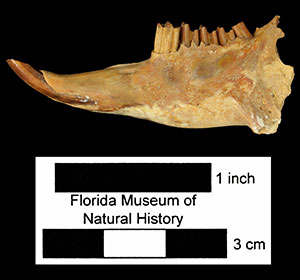
Quick Facts
Common Name: Webb’s marsh rabbit
Ecologically similar and probably ancestral to the modern marsh rabbit Sylvilagus palustris.
The largest known sample of specimens of the species (>4,500 bones and teeth) comes from the Inglis 1C site in Citrus County.
A mounted skeleton of this species is on permanent display inside a glass case at the Florida Museum of Natural History.
Age Range
- Early Pleistocene Epoch; late Blancan to early Irvingtonian land mammal ages
- About 2.5 million to 1.5 million years ago
Scientific Name and Classification
Sylvilagus webbi White, 1991
Source of Species Name: named after Dr. S. David Webb, a former paleontology curator at the Florida Museum of Natural History.
Classification: Mammalia, Eutheria, Euarchontoglires, Lagomorpha, Leporidae, Leporinae
Alternate Scientific Names: none
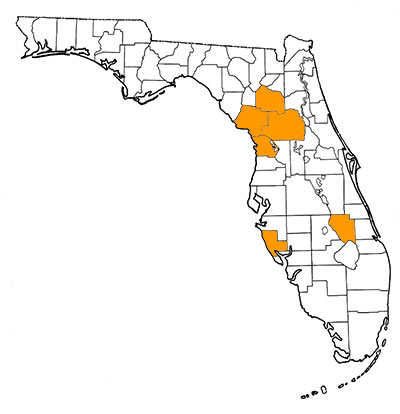
Overall Geographic Range
Fossils of this species have only been identified in Florida. The type locality is the Inglis 1A site in Citrus County, Florida.
Florida Fossil Occurrences
Florida fossil sites with Sylvilagus species:
- Alachua County— Haile 7G; Haile 16A; Haile 16B
- Citrus County— Inglis 1A; Inglis 1C
- Levy County— Waccasassa River 9A
- Marion County— Withlacoochee River 1A
- Okeechobee County— Kissimmee 6
- Sarasota County—Macasphalt Shell Pit 1
Discussion
Lagomorpha is a mammalian order than includes two families, the Ochotonidae (pikas) and Leporidae (rabbits and hares). Lagomorphs are related to, but are themselves not, rodents. While fossil pikas are not known from Florida or even the southeastern United States, fossils of rabbits and hares are common (Hulbert, 2001). Sylvilagus webbi, Webb’s marsh rabbit, is a relatively recently described species of extinct rabbit that is known only from the Blancan and Irvingtonian land mammal ages of Florida. It belongs to the only extant leporid subfamily, Leporinae. While the type locality of this species is the Inglis 1A site in Citrus County, Florida, Sylvilagus webbi is very well represented in the nearby Inglis 1C site, where they make up some 75% of the total number of identified specimens (Ruez, 2002). Webb’s marsh rabbit is about the same size as the extant marsh rabbit Sylvilagus palustris, and it has been suggested that Sylvilagus webbi evolved into Sylvilagus palustris sometime in the later Irvingtonian land mammal age (White, 1991). In turn, it is thought that Slyvilagus webbi evolved from an older extinct rabbit species, Sylvilagus hibbardi.
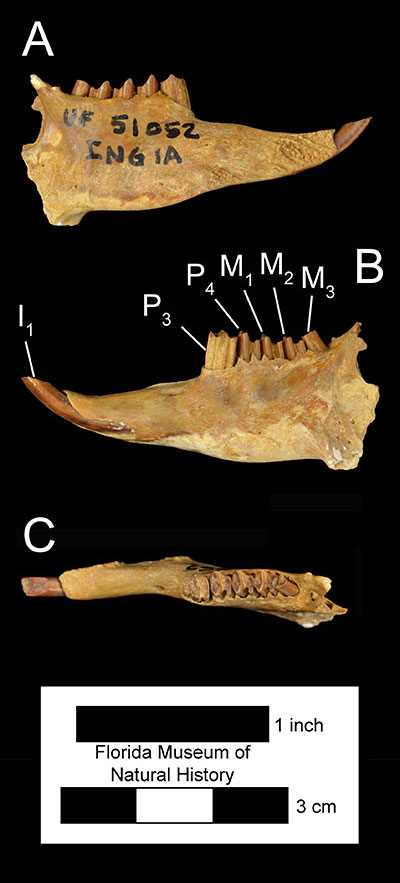
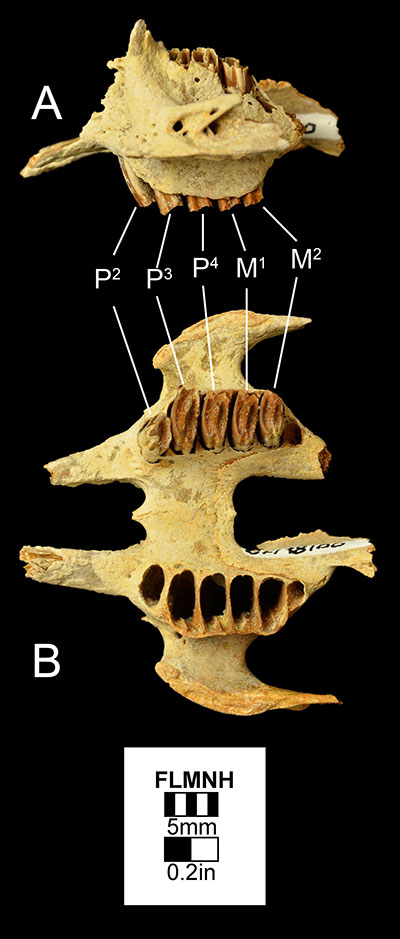
Sylvilagus webbi can be distinguished from other rabbits based on the morphology of the lower third premolars. This is because while features of the skull and teeth easily distinguish rabbits from other mammals, many cranial elements provide limited information when identifying species of similarly-sized lagomorphs. Lagomorphs are similar to rodents in having an ever-growing pair of incisors and a long diastema between them and the cheek teeth, but are unique in possessing a second pair of smaller incisors, colloquially called peg teeth, in their maxilla just posterior to the larger first pair of incisors. The skulls of lagomorphs are also characterized by fenestrations, or porous cavities, particularly just anterior to the orbits, which often do not fossilize well (Hulbert, 2001). Many cheek teeth of lagomorphs, with the exception of the lower third premolar, are nearly identical within the tooth row and are not helpful in diagnosing species or tooth position. In particular, isolated upper third premolars through the second molar and isolated lower fourth premolars through second lower molars are often unidentifiable to original position (Figures 2 and 3). On the other hand, the anatomy of the lower third premolar (Figure 4) based on the folding of enamel, dentine, and cement allows distinction to the generic, and sometimes even species, level (Hulbert, 2001). This makes the lower third premolar of lagomorphs critical for diagnosing differences between species.

Inward folds of enamel filled by cement in the teeth of lagomorphs are known as reentrants (Hulbert, 2001). The number and pattern of reentrants on the lower third premolar may be used to identify different groups of lagomorphs. For example, Sylvilagus webbi may be distinguished from the extinct rabbit Sylvilagus hibbardi by having more anterior reentrants on the lower third premolar. Sylvilagus webbi has 3.5 anterior reentrants on average and up to 7, but most Sylvilagus hibbardi have 1 or 2. Furthermore, the lower third premolar of Sylvilagus webbi has a posteroexternal reentrant that does not reach the lingual boarder of the tooth, which is unlike the condition found in the extant rabbits Sylvilagus auduboni (desert cottontail), Sylvilagus bachmani (brush rabbit), Sylvilagus floridanus (eastern cottontail), Sylvilagus nutallii (mountain cottontail), Sylvilagus aquaticus (swamp rabbit), Sylvilagus cunicularisus (Mexican cottontail), and Sylvilagus palustris (marsh rabbit), which all have posteroexternal reentrants that touch the lingual boarder. In size, Sylvilagus webbi has larger lower third premolars than Sylvilagus hibbardi, Sylvilagus auduboni, Sylvilagus bachmani, Sylvilagus braziliensis, Sylvilagus floridanus, and Sylvilagus nutalii. Compared to Sylvilagus aquaticus and Sylvilagus cunicularis, Webb’s marsh rabbit has smaller lower third premolars.
Postcranially, lagomorphs have fairly distinct skeletons with hollow limb bones, which is an unusual characteristic amongst mammals (Hulbert, 2001). Unfortunately, within the lagomorphs, postcranial bones are not often identifiable to the species level due to similarities in anatomy and size (Ruez 2002). Nevertheless, a large number of the postcranial elements have been attributed to Sylvilagus webbi from the Inglic 1C site based on dental evidence that the only species of lagomorph present at that locality was Webb’s marsh rabbit (Fig. 5).
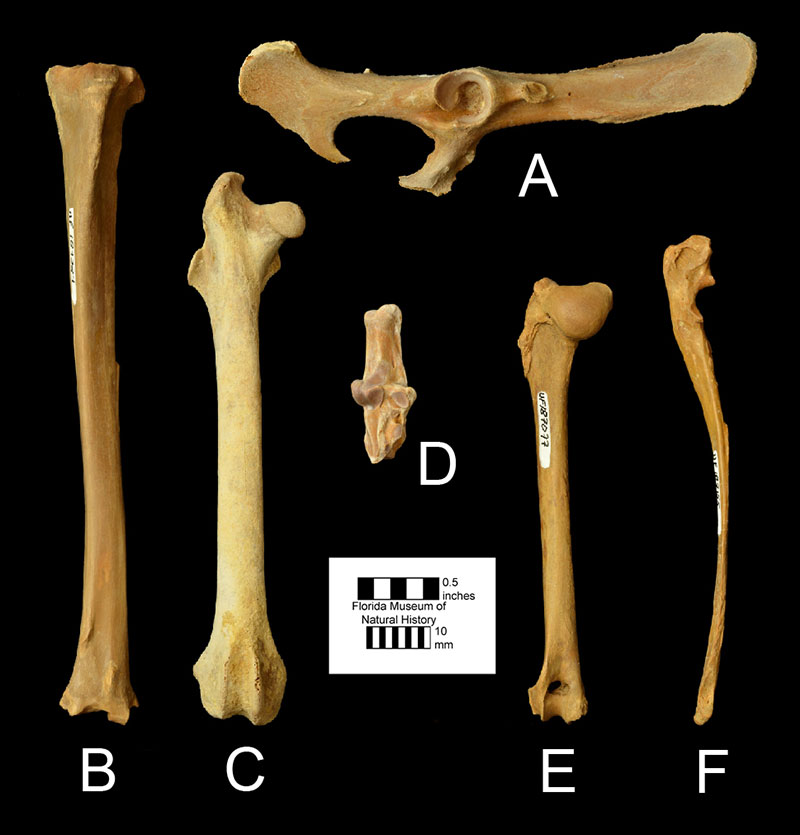
Sources
- Original Author: Arianna Harrington
- Original Completion Date: May 15, 2015
- Editor: Richard C. Hulbert Jr. and Natali Valdes
- Last Updated On: May 29, 2015
This material is based upon work supported by the National Science Foundation under Grant Number CSBR 1203222, Jonathan Bloch, Principal Investigator. Any opinions, findings, and conclusions or recommendations expressed in this material are those of the author(s) and do not necessarily reflect the views of the National Science Foundation.
Copyright © Florida Museum of Natural History, University of Florida